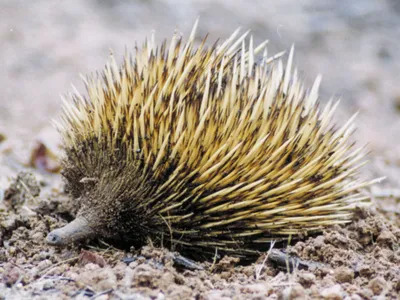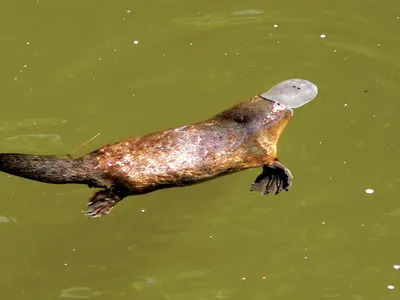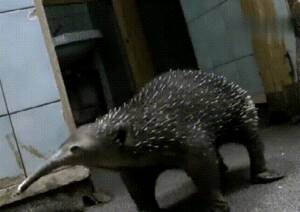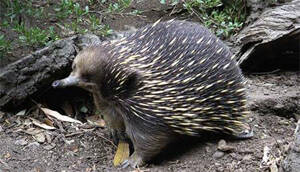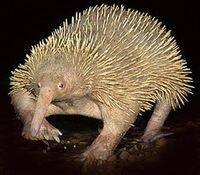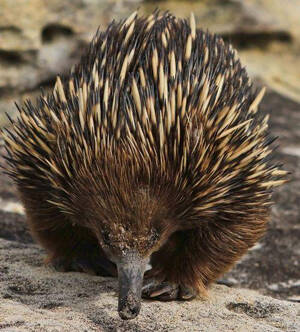Tachyglossidae
IUCN
ENBasic Information
Scientific classification
- name:Tachyglossidae
- Scientific Name:Spiny Anteater,echidna
- Outline:Monotremata
- Family:Tachyglossidae Monotremata Mammalia Chordata
Vital signs
- length:40-60cm
- Weight:2.3~10kg
- lifetime:50years
Feature
One of the most primitive mammals and one of only two monotremes in the world.
Distribution and Habitat
Echidnas are only distributed in Australia and New Guinea. Due to habitat destruction, illegal hunting and invasive alien species, echidnas have been listed as endangered species and have received widespread attention and protection from the international community.
Appearance
Appearance: The echidna is similar in appearance to a hedgehog, with hard spines on its back and sides that can fall off and regenerate. These spines are specialized hairs made of keratin. The body length is generally between 40-60 cm, with a very short tail, small eyes and ears, and well-developed external ear shells. The head is grayish white, with a hard, hairless beak in the front, which is cylindrical and curved downward. The nostrils and mouth are located at the front of the beak, and there are no teeth. The claws are hard and sharp, suitable for digging.
Details
Echidna, or Tachyglossidae, is commonly known as the spiny anteater. It is a surviving monotreme along with the platypus. There are three genera and six species in this family, of which the giant echidna is extinct, and the other two genera live in Australia and New Guinea.
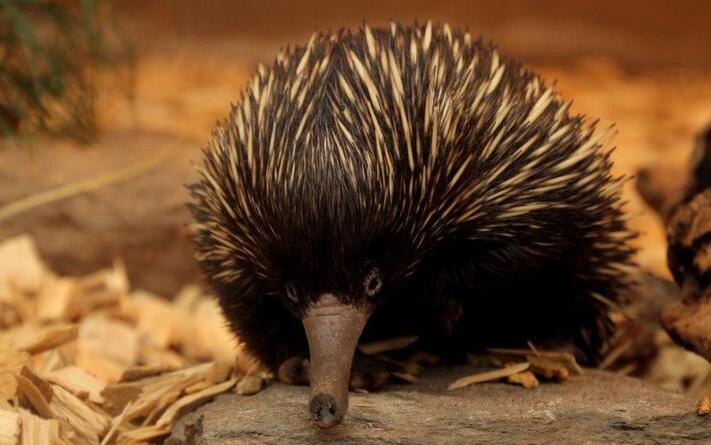
Echidna is a warm-blooded animal, with a body temperature that fluctuates by 6 to 8 degrees Celsius during the day. It is a wonderful combination of animals, and its appearance is very deceptive. It not only has the spines of a hedgehog, but also has a long nose like an anteater and a kangaroo-like pouch.
It is one of the most primitive mammals. There are 2 genera and 4 species. The back and sides of the body are covered with hard spines, and there are hairs under the spines; the ventral side is free of spines and covered with hairs, with a less hairy area in the center, where the female's pouch is formed; there is a single cloaca opening near the base of the tail. The digestive tract, excretory tract, and reproductive tract all open into the cloaca at the back of the body, so it is also a primitive, low-level, and strange mammal.
Morphological characteristics
The echidna has a grayish-white head with a hard, hairless, tubular long beak in the front. There are no teeth in the mouth, just a small hole that bends downward; the nostrils and mouth are located at the front of the beak; the tongue is long and has mucus, which is used to feed termites and ants; the limbs are hard, and each toe has a powerful hook claw, which is long and sharp and can be used to dig soil and ant nests. The back of the body is covered with hollow and hard thorns of varying lengths, and it looks like a hedgehog. The body surface is also covered with brown or black hair, and the hair on the ventral side is short, soft, and lighter in color. The eyes and ears are very small, but have well-developed external ear shells. There is no tail. The claws are hard and sharp.
The male has a spur on the inner side of the hind foot. But in fact, echidnas and hedgehogs are very different animals, and they are very far apart in terms of kinship. Hedgehogs are insectivorous mammals, but echidnas are close relatives of platypuses. They belong to the same monotremes among mammals. The digestive tract, excretory tract and reproductive tract all open in the cloaca at the back of the body, so they are also a primitive, low-level and strange mammal.
The short and sharp spines on the echidna are its amulets, but these spines are not firmly attached to the body. When encountering enemies, echidnas will curl up into a ball or burrow into loose soil and disappear quickly. Echidnas can dig holes in the soil at an amazing speed and bury themselves in the soil. The spines on the hedgehog are bone spines, which are cone-shaped and firmly attached to the body. They have no barbs and cannot fly away from the body into the body of the enemy. Pliers are needed to pull them out after death. The echidna's fur is black and soft.
The reproductive organs are very unique. Their penis is usually hidden in the body, and there are no testicles that descend into the scrotum, and there is no scrotum at all. This design makes echidnas very different from other mammals. Their main food is termites and ants, and sometimes they dig insect eggs and pupae to eat. The structure of the reproductive organs of echidnas, coupled with the cream-colored 5-centimeter-long spines covering their bodies, allows them to reproduce effectively while protecting themselves. This feature of the reproductive organs of echidnas, as well as their living habits, are the result of adapting to their living environment.
Habitat
Echidnas live in the ancient ecological environment of Australia with an ancient lifestyle. They live in areas such as shrubs, grasslands, sparse forests and rocky semi-deserts in inland desert areas, hiding in caves during the day.
Living habits
Behavior
Echidnas do not climb trees, but they are extremely good "engineers". They can dig the soil quickly, and they don't care even if the soil is hard. In less than ten minutes, echidnas will burrow into the soil and hide. However, under natural conditions, echidnas do not build their own nests, but use the dwellings of other animals. Even when echidnas want to dig in the soil, they only hide the lower part of their body, leaving the upper part exposed, because they always rely on the thorns to protect.
themselves. In addition, echidnas will curl up into a ball, like a hedgehog. It is difficult for echidnas to keep the hair between the thorns clean, which is also the same as hedgehogs. There are usually parasites in the hair, so they are always scratching. Nature has equipped the second toe of the echidna's hind foot with a long curved claw, which is used to comb the hair and scratch it.
Echidnas have poor eyesight, but they can keenly detect slight vibrations in the soil. They mainly eat ants and insects. Their mouths are long and tubular, without teeth, and their tongues are long and flexible. However, if they have the opportunity, they will not object to changing their diet, but they can only eat food that can pass through the small holes in their "elephant trunk"-like mouths. Unlike their close relative, the platypus, echidnas can go for long periods of time without food or water, sometimes even up to a month. It seems that they are in a state similar to hibernation from time to time. This is probably an adaptation to the environment. They live in Victoria and Tasmania, where the winter temperature is relatively cold.
Like the platypus, echidnas are also good swimmers and often go to the water to comb their hair. Judging from their excellent "dog paddle" swimming style, their ancestors may have been well adapted to foraging in the water.
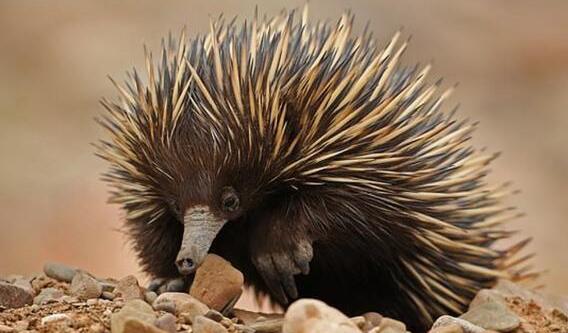
Predation
Although echidnas have small eyes and poor eyesight, they can keenly detect slight vibrations in the soil. Their mouths are solid and long, with no teeth in the upper and lower jaws. Their tongues are more than 30 cm long, flexible and have barbs, and can be extended far out of their mouths. Usually, echidnas live in caves and go out in the afternoon and evening. They often insert their hard, pointed mouths into anthills, and then extend their slender and mucus-filled tongues to feed on termites and ants in the anthills. In addition to using the mucus on its tongue to pick up food, it often uses the small hooks on its tongue to catch food. Because it has no teeth, the echidna's food is limited to those animals that can be caught with its tongue. However, they have survived tenaciously and have not changed much for at least 80 million years.
There are reasons why echidnas can survive successfully. Their main prey is ants, which are the most successful of all insects and are distributed in the most extensive areas. Echidnas focus on eating ants. Its thick legs like shovels are more suitable for digging than walking, and it is this clumsy digging that makes it more adaptable to the environment. Echidnas can use their long, hard tongues very skillfully to grope deep into ant nests.
Echidnas go out to look for food for eighteen hours a day. They have an electro-sensory system. Through the hundreds of electro-sensory organs on their noses, echidnas can keenly detect the electrical signals of animals, and use their noses to detect and find ants, earthworms and other invertebrates. Their mouths and noses can detect and sense very subtle biological electronic signals, find various insects buried in the soil, and quickly catch food. Echidnas will eat in ant nests for up to half an hour, swallowing thousands of termites. They cannot chew because they have no chewing muscles or teeth. They can only crush food on the back of their tongue. In order to find food, echidnas have to wander back and forth for eighteen kilometers a day. They mainly feed on termites and ants, and sometimes eat other small invertebrates such as insects and worms.
They are like miniature four-wheel drive vehicles, running around with short but flexible legs, using strong limbs and claws to probe into logs and ant nests, and then using long and sticky tongues to catch prey. The tongue works very efficiently, so the scientific name of the echidna means "fast tongue (Tachyglossus)"
Defense
Echidna looks like a hedgehog, but these spines are not firmly attached to the body. When they encounter an attack, these barbed spines will shoot into the enemy's body like an arrow. The short and sharp spines on the echidna are its amulets. When defending against enemies, the echidna has two tricks. One is that when it is frightened, it will quickly curl up into a ball like a hedgehog, so that the enemy will only see a headless "ball of thorns" and it is difficult to attack. Another is that its limbs are short and powerful, with five or three toes, and the toes are sharp claws, which can quickly dig the soil, and then bury the body underground, or hook the roots of trees, or fall into the cracks of rocks, so that the opponent cannot eat it.
Echidna can dig with all four limbs at the same time. It digs the soil on the ground to both sides of the body so that it can drill vertically downward. When the echidna's unprotected belly drops to the ground, it uses its thorns to form a fairly effective defense system to resist any possible predators. When encountering an enemy, the echidna will curl up into a ball or burrow into the loose soil and disappear quickly. The echidna can dig a hole in the soil at an amazing speed and bury itself in the soil. The thorns on the echidna are very sharp and have barbs. Once it encounters an enemy, the echidna will turn its back to the enemy, and its thorns can break away from the echidna's body and pierce the body of the intruder. After a period of time, new thorns will grow at the place where they fall off.
Distribution
Distributed in Australia (Australian Capital Territory, New South Wales, Northern Territory, Queensland, South Australia, Tasmania, Victoria, Western Australia), Indonesia and Papua New Guinea.
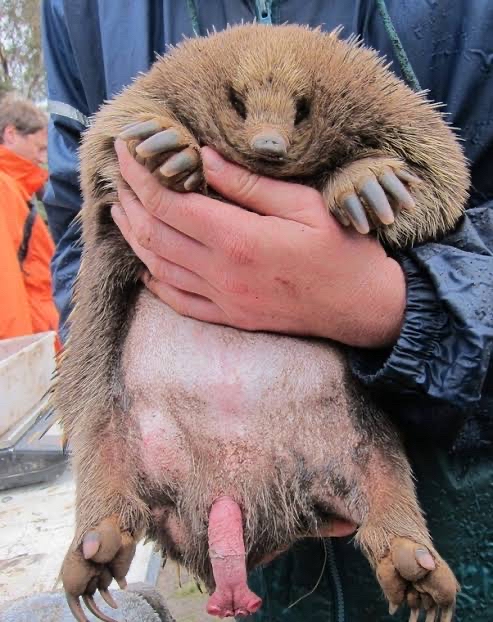
Reproduction method
May is the breeding season for echidnas. At this time, a kangaroo-like pouch will grow on the abdomen of the female. The pouch is a crescent-shaped, coarsely haired sac, a skin fold formed by muscle contraction, which only appears during the annual breeding period, allowing the eggs to hatch in it. The incubation period is about 10 days, becoming a temporary pouch and covering the nipple area of the abdomen. In addition, there is an upper pubic bone connected to the pelvis, which may be used to support the eggs or young in the bag.
The mating of echidnas is really a spectacular spectacle. The design of the male echidna's reproductive organs is so peculiar that it is simply amazing. There are actually four "heads" at the front of their reproductive organs. This structure is rare in the animal kingdom. During the mating process, these four "heads" will take turns to fight, and only two will be used at a time to ensure the success rate of mating. The male echidna adapts to the female's reproductive tract by contracting and expanding to ensure that the sperm can be smoothly transmitted and complete the continuation of life. When laying eggs, the female bends her body like a caterpillar and aligns her cloaca with the pouch, so that the eggs fall into the pouch when they flow out of the cloaca. At the same time, some very sticky liquid flows out of the cloaca, sticking the eggs to the hair of the pouch. Most females only lay one egg, and occasionally two. Since it has no fixed residence, the eggs are carried and incubated by the female after they are laid. The eggs of echidnas are white, with a large yolk inside and no egg white. They are about 15 mm long and 13 mm in diameter, about the same size as the eggs of platypuses. The surface of its eggshell is very rough, like coarse parchment, much like the leathery eggshells of many reptiles.
Echidnas have a very strange characteristic. They will send the newly laid eggs to the pouch on their abdomen, just like kangaroos and other marsupials put their young in the pouch, and incubate them in the pouch. After a few weeks of incubation, the young will hatch. The newly born young, less than 12 mm long, stays in the pouch to continue growing. The newborn baby echidna weighs only 0.4 grams. The first thing the newborn baby echidna has to do is to find milk. Echidnas do not have nipples, but they can still breastfeed. Echidnas have unique nipples in their pouches, and the young can only lick the milk flowing from the nipples on the abdomen of the female in the pouch. When the baby echidna stimulates the skin in the pouch, milk will be secreted from special pores. The milk is very thick and becomes thicker as the baby echidna grows.
The baby echidna sleeps in the pouch and raises its head to lick the milk. After 7 or 8 weeks, the cub's back grows thorns, and the female animal takes them out and hides them in a more secluded place such as bushes to continue nursing. Then the female animal's temporary pouch disappears naturally.
This special feeding method is similar to that of the platypus. The platypus also has no breasts and nipples, but it has very small nipples on both sides of the abdomen for secreting milk. When the baby animal lies on the mother platypus's belly, it only needs to lick it gently to drink the milk secreted from the nipples without sucking hard.
This unique way of breastfeeding shows the diversity of animals' adaptation to the environment. Although there are no traditional breasts and nipples, through the special physiological structure evolved, echidnas and platypuses can still effectively feed their offspring.
When the young echidna hatches from the egg, it is no more than 12 mm long. They lick the thick light yellow milk from the mammary glands on the mother's fur. The young echidna lives in the pouch until the spines grow on its back, which is usually 6-8 weeks and the body length is 9-10 cm. At this time, the female echidna takes the young out of the pouch and hides it in a more secluded place such as bushes to continue nursing. After 50 days, when the young echidna has grown a spine, the female echidna pushes the young out of the body. After five weeks, the young echidna can live independently. At one year old, the young echidna is sexually mature, weighing 2.5-6 kg, and the spines on its back are up to 6 cm long.
Population status
The species of this genus have a narrow and limited distribution range and are believed to have a moderate trend of decreasing numbers. The decline is due to habitat loss, reduced precipitation, tourism impacts, and road development, which have caused changes in the living environment. It has been listed as vulnerable and critically endangered.
Echidnas are divided into three genera, namely Echidna, Protoechidna and Giant Echidna. There is only one species in the genus Echidna; only three of the five species in the genus Protoechidna are still alive; and both species of the genus Giant Echidna are extinct.
Echidna
Short-beaked echidna (scientific name: Tachyglossus aculeatus):
Also known as the spiny anteater, it has both hair and spines on its body, a long beak, feeds on termites, etc., and is good at digging. Although echidnas are oviparous monotremes, they also have pouches. The eggs are laid directly in the pouch for incubation, and the young continue to live in the pouch for a period of time after hatching.
Short-beaked echidnas are the most widely distributed and common monotremes in existence, distributed throughout the Australian continent, Tasmania, and central and southern New Guinea. The short-beaked echidna of Tasmania is more furry and was once considered a separate species.
Protoechidna
Attenborough's long-beaked echidna (Zaglossus attenboroughi):
It is the smallest member of the Protoechidna genus, similar to the Australian echidna. It has five toes on both the front and back limbs and is densely haired.
Due to human development affecting the forest habitat, it is said that they are endangered or extinct locally. However, since biological research in Papua Province is incomplete, it is possible that they still live in the local mountainous areas. In 2007, it was reported that the nest and traces of Attenborough's long-beaked echidna were discovered, and local people also said that they had seen them in 2005.
Long-beaked echidna (Zaglossus bruijni):
It weighs up to 16.5 kg, has a long and downward-pointing snout, and its spines are mixed in with long hair. Almost twice the size of the short-beaked echidna, it is the largest member of the monotremes, with a long curved beak, short and sparse spines, and more hair. Both the front and rear limbs have three claws, which are hard and sharp and suitable for digging.
It lives in highland forests. It is listed as an endangered species by the World Conservation Union, and its number has declined due to habitat loss and hunting. Although hunting long-beaked echidnas has been banned by the governments of Indonesia and New Guinea, traditional hunting continues. In 2006, Conservation International discovered a large number of long-beaked echidnas in the Fuya Mountains in Papua Province.
Big long-beaked echidna (Zaglossus bartoni):
There are 4 different subspecies. Each subspecies is separated geographically, and the main difference between them is body size. There are five toes on the forelimbs and four toes on the hind limbs, all of which have claws. It weighs 5-10 kg and is 60-100 cm long, making it the largest monotreme. It has thick black hair, no tail and moves slowly. They curl up their bodies to defend themselves when attacked.
They are mainly found in Papua New Guinea at an altitude of 2,000-3,000 meters.
FAQ
1. What is an Echidna?
Answer: The echidna is a unique monotreme (egg-laying mammal) found primarily in Australia and New Guinea. It is known for its spiky exterior, similar to that of a hedgehog, and feeds mainly on insects, especially ants and termites.
2. How does the echidna protect itself?
Answer: When threatened, an echidna curls up into a tight ball, exposing its sharp spines to deter predators. The spines are its primary defense mechanism and are effective in scaring off enemies.
3. How does the echidna reproduce?
Answer: Echidnas are egg-laying animals. The female lays one or two eggs, usually in an underground burrow for incubation. After hatching, the young echidnas rely on their mother's milk, although she does not have nipples; instead, the milk is secreted through the skin.


